The strange case for human beings having descended from ....?
“The question of questions for mankind — the problem which underlies all others, and is more deeply interesting than any other — is the ascertainment of the place which Man occupies in nature.”
-Aldous Huxley
"We like to think that we base our beliefs on evidence, but some may notice that far more often we arrange the evidence to fit our beliefs. Distorting or excluding what won't fit, seeking out evidence that will, and surrounding ourselves with others who affirm them"
-Charles Eiseinstein in The More Beautiful World Our Hearts Know Is Possible

Human Origins. Are we actually hybrids?
Hybrid - derived from latin hybrida, a variant of ibrida, meaning an offspring of a tame sow and a wild boar. Of unknown origin but likely Greek and somehow related to hubris. 1
This is a messy topic. It hasn't been discussed much or and certainly not discussed well. It's messy biologically, it's messy sociologically, it's messy taxonomically and perhaps worst of all, it's messy emotionally(maybe most of all for people with professional reputations dependent on being right).
Thus, let us start simple. Hybrids. We all know hybrids are a thing.
Ligers are a cross between a lion and a tiger.
Mules. Horse x Donkey
Zebroids. Zebra X any other equine
Cama. Camel x Llama
Geep. Sheep x Goat
Wholphin. False Killer Whale x Dolphin
Coy-Wolves. Wolfs x Coyotes x Dogs
These are only a few of the more well documented ones. So, how come this works? What a great question!! The short answer is, we don't know, but it does.
But aren't they different species?
Yes, they are, moreover that is actually the definition of a species...a group of similar individual beings that are capable of exchanging genes. So by that definition Camels and Llamas are actually the same species? Hmmm, does anyone else starting to get the feeling that we're using an outdated set of models here?
So, where exactly did the word species come from to begin with?
14c as a classification in logic, from latin species 'a particular sort, kind, or type', from specere 'to look at, to see, to behold', from Proto-Indo-European spek; to observe.
It appears though our forebears using the word to classify or group things based upon their observations. Great. Let us then, not stop observing :P and continue on, we have a ways to go yet.
Ring Species (species as a spectrum)
A ring species is a certain phenomena where we again see the concept itself of species fraying along the edges. Ensatina salamanders are an example. They live around the edges of the central valley in California, but not in the center of the valley.
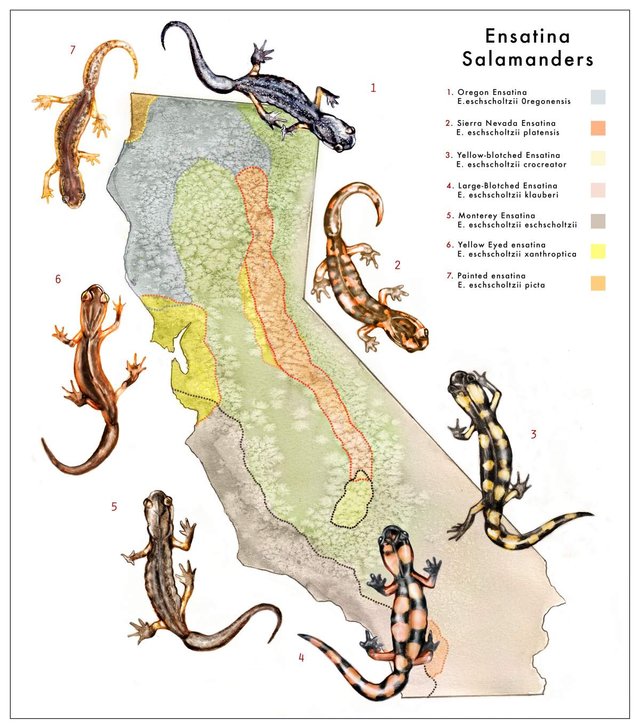
Note the habitat does not connect around the southern tip of the valley, thus it's not quite a complete circle, more like a circle with a bite taken out of one side(in this case the bottom). When scientists began studying these salamanders at first it was thought that there were several different species, and they observed that the salamanders on one side of the valley were largely unable to reproduce with salamanders on the other side.
Fast forward several more decades of research(and observation!), and we've realized that if you take two salamanders from a similar area along any point of the ring, they can typically breed just fine, despite their markings. Yet, two salamanders from opposites ends of the ring, and it doesn't work. YET...those same two salamanders are still exchanging genes that end up traveling through the entire length of the ring, hopping from close neighbor to close neighbor.
So how many species of ensatina salamanders are there?
Well..as you may be beginning to realize, that's a looking like a more and more useless question, there can be as many species as we like :P But that mostly just exists in our heads. The salamanders will still be salamandering along in a tidal wash of cross species genes surfing around the central valley.
I only bring all this up to attempt and illustrate a little thing that I think is very important to remember at the bottom of all this.
Reality is not the words we use for it.
or in a different way
The name is most emphatically not the thing.
A coyote is not a coyote. You are not a human. Symbols. Representative. That's it...a word, a symbol represents something, it is not actually that thing. In this way, let us try to avoid falling in the trap of believing our symbols, and not actually, truly observing.
Great Itchy! So what does this have to do with the origins of Human Beings?
I have absolutely no fucking clue. I just came here to babble and pretend like I have friends
Just kittying. I'm realizing that in trying to write this damn story for the last week, I am finding myself caught up in trying to LOGIC it, or to ORCHESTRATE it beautifully or some shit...I care a lot about trying to convey this convincingly, cohesively, and effectively. But who the fuck am I kidding? You're probably drunk, or strung out on too much Steemit, sucking down information at an alarming rate.
You know, whatever! Either you're going to read this thing and be like "Holy Fuck, that shit is crazy, and wow, human noses sure do look funny now" or, you're one of those people that can't read anything longer then a paragraph already anyway, thus it doesn't actually matter what I write here.
It seems to me that we humans have quite likely descended from an ancestor of the pig
Gee Itchy, don't you think that if we had descended from an ancestor of modern day pigs, that science would know this by now?
Yes, actually. I would think.
Alright, lets start getting specific. I've been reading Gene McCarthy's work, which is thoroughly documented on his website. And who knows?!! Maybe he just convinced me to join his cult or whatever...but fucking hell, how could the scientific community not explore this? How could we are humans not see it? How daft can we possibly be?
Right, the theory. I am going to let Gene start us off.
So why do I think humans are hybrids? Well, first of all, I’ve had a different experience from most people. I’ve spent most of my life (the last thirty years) studying hybrids, particularly avian and mammalian hybrids. I’ve read thousands of reports describing them. And this experience has dispelled some mistaken ideas I once had about hybrids, notions that I think many other people continue to take for granted.
For example, one widespread, but erroneous, belief is that all hybrids are sterile. This idea keeps a lot of people from even considering the possibility that humans might be of hybrid origin. The reality, however, is something quite different. For instance, in reviewing the reports I collected for my book on hybridization in birds, which documents some 4,000 different kinds of hybrid crosses among birds, I found that those crosses producing partially fertile hybrids are about eight times as common as crosses known to produce sterile ones. The usual result is a reduction in fertility, not absolute sterility. My current work documenting hybridization among mammals shows that partially fertile natural hybrids are common, too, in Class Mammalia. And yet, it seems most people base their ideas of hybrids on the common mule (horse x ass), which is an exceptionally sterile hybrid, and not at all representative of hybrids as a whole.
I should, perhaps, also mention that differences in parental chromosome counts, even rather large ones, do not preclude the production of fertile hybrids. While differences of this sort do bode ill for the fertility of the resulting progeny, it is only a rule of thumb. For example, female geeps, the products of hybridization between sheep (2n=54) and goats (2n=60), can produce offspring in backcrosses. Likewise, female zeedonks (Burchell’s Zebra, 2n=44 x Ass, 2n=62) have also been fertile in backcrosses. There are many other examples of this sort among mammalian hybrids. Therefore, such differences between the parents in a cross do not in any way guarantee an absolute sterility in the hybrid offspring. (For those readers who do not know, backcross hybrids are produced when hybrids from a first cross mate with either of the two types of parents that produced them. When the resulting progeny mate again with the same parental type, the result is the second backcross generation, and so forth.)
A second so-called fact, which might make it seem impossible for humans to have had a hybrid origin, is the equally erroneous notion that hybrids, especially successful hybrids, do not occur in a state of nature. A third is the mistaken idea that only plants hybridize, and never animals. In fact, however, natural, viable, fertile animal hybrids are abundant. A wide variety of such hybrids occur on an ongoing basis. For example, of the more than 4,000 different types of hybrid crosses listed in my book on hybridization in birds, approximately half are known to occur in a natural setting. My current research indicates a comparable rate for mammals.
-Gene McCarthy
Gene goes on to address the most common question at this point...Can't we just look at the DNA? You can read more about his answer here.
So why might we think humans are backcrossed hybrids?
The obvious reason is we are very similar to chimpanzees genetically, yet we possess an astonishing number of physical traits that are markedly different from chimpanzees. This exactly resembles the description of a backcrossed hybrid. If we descended from F1 hybrids without the backcrossing, we would be genetically halfway between chimpanzees and our other parent, but we're not. Moreover, in hybridized mammals, the females are typically much more fertile than the males. In a commercial context, you see livestock breeders backcrossing F1 hybrids back to one parent or the other. As a rule, they don't breed the F1 hybrids among themselves, often repeated backcrossing is necessary before you begin to see fertile males.
So, there actually is a very logical way to approach this. It's the same way that biologists approach any possible hybrid when they're attempting to identify it's parents. The important thing to understand is that when a hybrid happens, it combines traits from both of it's parents, and the extent of these traits will fall somewhere on a spectrum somewhere between the two parents.
First, you choose the most obvious parent you can find. In our case, this is obviously a chimpanzee (or more accurately the shared ancestor of a human and a chimpanzee). Then, you compare the two, and you create a list of differences. Lets go ahead and do that now.
“The scientist has a lot of experience with ignorance and doubt and uncertainty, and this experience is of very great importance, I think. When a scientist doesn’t know the answer to a problem, he is ignorant. When he has a hunch as to what the result is, he is uncertain. And when he is pretty darn sure of what the result is going to be, he is in some doubt. We have found it of paramount importance that in order to progress we must recognize the ignorance and leave room for doubt. Scientific knowledge is a body of statements of varying degrees of certainty — some most unsure, some nearly sure, none absolutely certain.”
— Richard Feynman
What are the differences between humans and all other primates
We're going to go ahead and use the entire primate family instead of only chimpanzees, just to be safe
Naked skin (sparse pelage)
Panniculus adiposus (layer of subcutaneous fat)
Panniculus carnosus only in face and neck
In “hairy skin” region:
- Thick epidermis
- Crisscrossing congenital lines on epidermis
- Patterned epidermal-dermal junction
Large content of elastic fiber in skin
Thermoregulatory sweating
Richly vascularized dermis
Normal host for the human flea (Pulex irritans)
Dermal melanocytes absent
Melanocytes present in matrix of hair follicle
Epidermal lipids contain triglyceridesand free fatty acids
FEATURES RELATING TO BIPEDALITY
Short, dorsal spines on first six cervical vertebrae
Seventh cervical vertebrae:
- long dorsal spine
- transverse foramens
Fewer floating and more non-floating ribs
More lumbar vertebrae
Fewer sacral vertebrae
More coccygeal vertebrae (long “tail bone”)
Centralized spine
Short pelvis relative to body length
Sides of pelvis turn forward
Sharp lumbo-sacral promontory
Massive gluteal muscles
Curved sacrum with short dorsal spines
Hind limbs longer than forelimbs
Femur:
- Condyles equal in size
- Knock-kneed
- Elliptical condyles
- Deep intercondylar notch at lower end of femur
- Deep patellar groove with high lateral lip
- Crescent-shaped lateral meniscus with two tibial insertions
Short malleolus medialis
Talus suited strictly for extension and flexion of the foot
Long calcaneus relative to foot (metatarsal) length
Short digits (relative to chimpanzee)
Terminal phalanges blunt (ungual tuberosities)
Narrow pelvic outlet
Diverticulum at cardiac end of stomach
Valves of Kerkring present in small intestines
Mesenteric arterial arcades
Multipyramidal kidneys
Heart auricles level
Tricuspid valve of heart
Laryngeal sacs absent
Vocal ligaments
Prostate encircles urethra
Bulbo-urethral glands present
Os penis (baculum) absent.
Hymen
Absence of periodic sexual swellings in female
Ischial callosities absent
Nipples low on chest
Bicornuate uterus (occasionally present in humans)
Labia majora
CRANIAL FEATURES
Brain lobes: frontal and temporal prominent
Thermoregulatory venous plexuses
Well-developed system of emissary veins
Enlarged nasal bones
Divergent eyes (interior of orbit visible from side)
Styloid process
Large occipital condyles
Primitive premolar
Large, blunt-cusped (bunodont) molars
Thick tooth enamel
Helical chewing
OTHER TRAITS
Nocturnal activity
Particular about place of defecation
Good swimmer, no fear of water
Extended male copulation time
Female orgasm
Short menstrual cycle
Snuggling
Tears
Alcoholism
Terrestrialism (Non-arboreal)
Able to exploit a wide range of environments and foods
Heart attack
Atherosclerosis
Cancer (melanoma)
FACIAL FEATURES
Lightly pigmented eyes common
Protruding, cartilaginous nose
Narrow eye opening
Short, thick upper lip
Philtrum/cleft lip
Glabrous mucous membranebordering lips
Eyebrows
Heavy eyelashes
Earlobes
The rule is perfect: In all matters of opinion, our adversaries are insane.
Mark Twain
That was pretty comprehensive list...I have no idea about what many of those words mean. We're about to go over some of the more salient ones.
Eyes, eyelashes, and eyebrows
- Humans have pigmented eyes in shades of blue, green and tan, this is not found in Chimpanzees(nor any other non-human primates), which have brown eyes.
- Humans are also the only primates with a sclera , the large whiteness surrounding your smaller pupil.
- Humans are the only primates with eyelashes, and eyebrows. Most primate have 'bony eye ridges'.
Pigs have eyes in blue, green, and shades of tan. They have a sclera, eyelashes, and eyebrows.
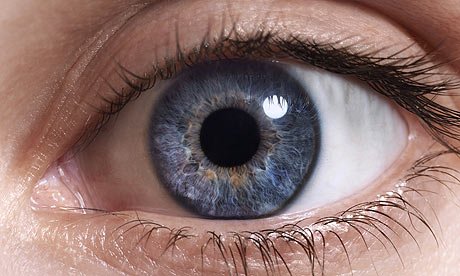
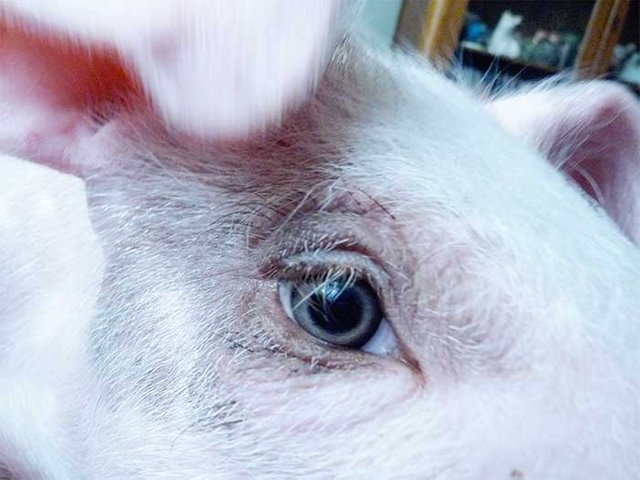
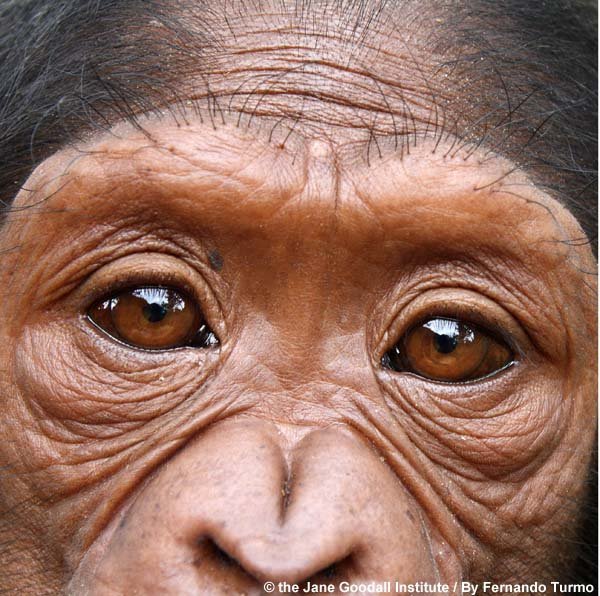
The nose
a protruding cartilaginous nose
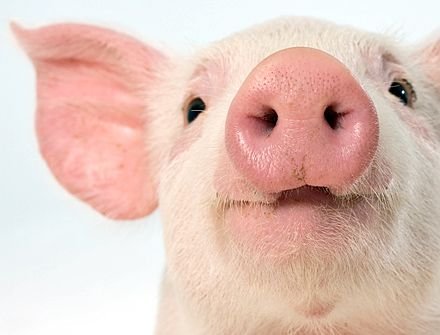
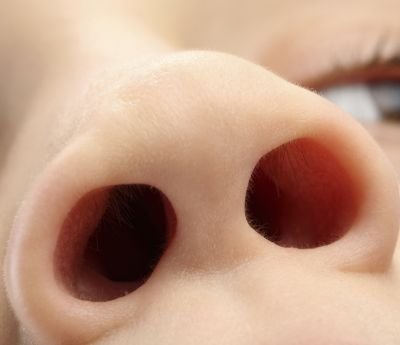
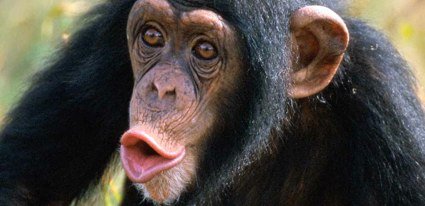
Hmmm, we don't quite look like a pig nose, but we definitely don't look like a Chimp nose
Hair density on our skin
Some people are hairier then others, but a human that had the hair density of a chimpanzee would be extreme. We tend to be a lot more 'naked'. Most wild pigs also have quite a bit more hair then the domestic varieties. Maybe we're domesticated too? Who knows.
Subcutaneous fat or adipose tissue
There are only two mammals on this planet with subcutaneous fat. Pigs, and humans. It's actually part of an incredible state of the art body temperature regulating system. Hunter-gatherer societies all across the world have made good use of this by doing their hunting in the heat of the day. Large game can't cool themselves off like we can, and it's a non-trivial but completely functional way of killing them, simply run them down in the heat until they collapse of heat exhaustion. The human system has no problem dissipating enough heat.
Thermo-regulative vasculature of our skin
The backbone of our cooling system is how our blood vessels actually reach up through our adipose tissue, as opposed to running parallel to the skin like other Primates. In conjunction with our sweat glands, this system can shed massive amounts of heat. We may be one of the most functional long range athletic beings on the planet under high heat conditions. Ever felt inspired to sign up for a 135 mile ultra-marathon across death valley in mid July? With temperatures up to 130f, the roster is capped at 250 people and sells out months in advance! Don't forget to bring a pig, they happen to be the only other mammal on planet earth with the exact same system.
Primates don't have long mane hair atop of the head (also don't have beards)
But guess who does?
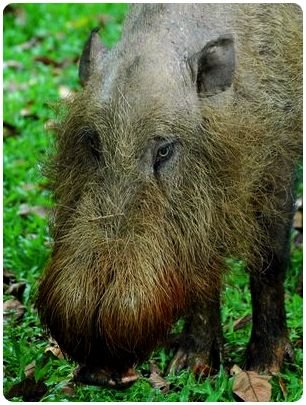
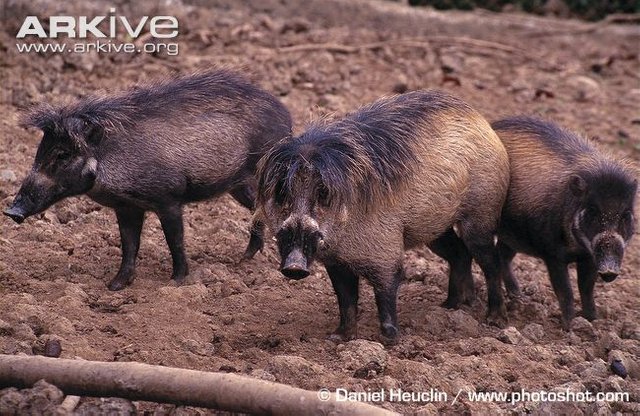
We share flea species with pigs, but not with primates
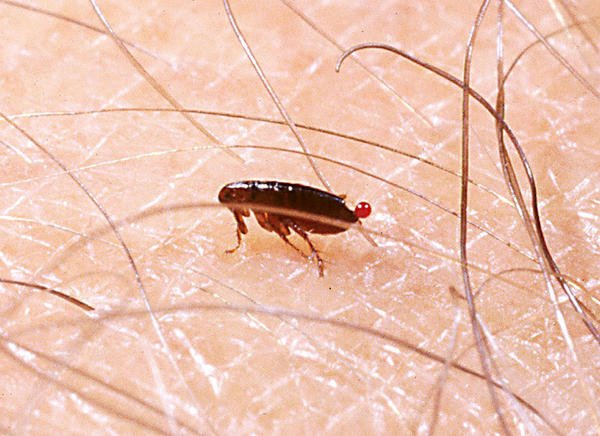
parasites are often quite specific about their hosts
The crisscrossed line pattern on the surface of our skin

thats pig skin

that ones human
All primates have longer arms then legs, in humans this is reversed
Pigs also have longer rear legs then their front
Females orgasms, labia majora, and extended male copulation times
So female non-human primates definitely can orgasm in a laboratory environment? (I wonder if they're accepting interns!) It doesn't appear to be the norm, but it has happened. In the wild, it's a lot less clear, but the short ejaculation times of most primates suggests that its not common
Female pigs have orgasms(some accounts up to 30 minutes!). They also have both labias, which supposedly chimpanzees don't...I couldn't find any pictures online. Male pigs require anywhere from 5 to 25 minutes to copulate, compared to primate copulations which are measured in seconds. You can actually find tons of pictures of pig labias, but I think I'll let you do that on your own time.
The brain
This is an interesting one. We've all heard talk of how smart pigs are. But they don't have particularly large brains. But, neither do chimpanzees. It's often tempting to utilize a brain to body-mass ratio for comparison of brain sizes between animals, however one complication is that even this ratio becomes skewed by size of the animal. For instance, Mice have an incredibly high brain to body mass ratio, and elephants much lower, even though elephants are considered one of the most intelligent animals in the world.
So why do we have large brains?
To start lets look at other primates. Why haven't they evolved larger brains too? There's a number of theories on the subject. One interesting one is simply that brains are very energy intensive, they require a LOT of calories to run, by some estimates the human brain burns between 20% and 40% of all your caloric intake, even though it's only about 2% of your mass. An even more interesting, but less often discussed, piece to that theory is cooling. It's all about surface area and volume. It's the square cube law, a basic tenant of calculus.
The ratio of surface area to volume declines as the size of an object increases. A large object has a small surface area in proportion to its volume. If heat is flowing out of an object, the rate at which it passes out will be directly proportional to the object's surface area.
Square cube law -Wikipedia
This means that as a brain grows larger, it's proportional surface area is decreasing. The amount of energy required is growing linearly as we increase the mass of the brain, yet the surface area(it's ability to dissipate heat) is decreasing exponentially...this results in serious cooling troubles the larger you go. You see this perfectly in existing primates, the larger species brains seem to hit a 'cap', thus larger primates(gorillas, orangatangs, etc) brain size ratios taper off quickly compared to their smaller relatives. For what it's worth, scientists have only recently began to understand Elephant's thermo-regulative systems.
Dysfunctional spermatozoa
It has been well understood for decades that humans are strangely infertile compared to chimps (and most other mammals). And it's not just the appearance of sperm; a high percentage of human spermatozoa are totally dysfunctional (92 times higher than the percentage found in a Chimp). It would seem a difficult proposition to argue that this massive increase to infertility was actually the result of natural selection.
Frequent use of pigs in human surgical treatment
We use pig heart valves to replace ones damaged through heart disease. Pig skin is used in the case of burn victims. Serious efforts have been directed at using pig kidneys and other organs for transplants. Why not goats, dogs, or bears?
For those of you into Philosophy
I believe it's worth pointing out that Occam's Razor has solid application here. For each such feature listed above in the content of this post, we would have to come up with a separate argument, supporting how the feature has helped both pigs and humans to survive and reproduce. On the other hand, a single, simple assumption (that modern humans, or earlier hominids that gave rise to modern humans, ultimately arose from a cross between pig and chimpanzee) will account for all of these features at a single stroke.
Wrapping it up
Wow. I know this is a lot of information, and probably brings up a few weird feelings too. So, as always, I would encourage you to look around you with your own eyes, do your own research. Don't believe everything that gets published by a major news network, or an independent scientist living in Georgia. You should read everything you can from all sources, and draw your own conclusions. Or don't. A wiser person than myself once told me
Good questions are hard to come by. When you find one, don't be in such a hurry to answer it.
- Martin Prechtel
or as any good programmer knows
Love your problems, not your solutions
After all, isn't Science at it's core just a method of questioning? In that spirit, I'd like to suggest you take this for what it is...simply some interesting observations that raise great questions.
I sincerely hope you have enjoyed thinking about them with me
-ItchyKitten
Man I don't now how I missed this one, right up my street! Beautifully written and very thought provoking, in fact I shall have to go and read/ponder this one some more.
thanks perceptual!!! that makes me all warm and fuzzy inside ! I'm super happy we are both here and friends on Steemit!!!
@itchykitten no worries my man and likewise. I love reading your posts, you're infectious vibrancy and energy leaps off the page with each new word and I love your open-minded approach to life .. keep up the excellent work. I've been doing all my business invoicing/accounts the last few days so I kind of have to change my mindset as it's really not conducive to creative thought. But I'm nearly finished and will be back to give this beauty the contemplation it so richly deserves.
awwwwwww shucks!!! You big sweetheart, haha buttering me up real good, you can come tell me those things whenever you like !!! I've really enjoyed meeting you, and getting to chat a bit over the last week or so. I hope it's just the beginning :P
Haha no worries my man .. credit where it's due, what a great post! huge amount of info on a subject I've been completely oblivious to. I can certainly appreciate the points you're making here and it's inspired me to delve further .. although I may skip the pigs labias! lol I don't know if I'm brave enough to go looking, and not sure what my wife would make of my browsing history lol :D
hahaha!! It's for science!
English version below
Excellent post! J'aime me questionner et là j'ai été servi! :-) J'adore ta façon de mettre de la vie dans ton texte comme par exemple ces quelques perles:
«Ever felt inspired to sign up for a 135 mile ultra-marathon across death valley in mid July?»
«But guess who does?» Quand tu parles des cheveux et de la barbe.
«You can actually find tons of pictures of pig labias, but I think I'll let you do that on your own time.»
Tu m'as fait sourire et rire!! Merci . Et surtout, je partage ton opinion, à savoir qu'il est vraiment essentiel de se questionner et de réaliser que la science est loin d'avoir les réponses, elle observe et suggère tout simplement.
J'ai bien hâte de lire d'autres post comme celui-ci! Merci d'avoir pris le temps de l'écrire et bonne journée!
Excellent post! I like to question myself and there I was served! :-) I love your way of putting life into your text as for example these few pearls:
«Ever felt inspired to sign up for a 135 mile ultra-marathon across death valley in mid July?»
«But guess who does?» When you talk about hair and beard.
«You can actually find tons of pictures of pig labias, but I think I'll let you do that on your own time.»
You made me smile and laugh !! Thank you . Above all, I share your opinion that it is truly essential to question oneself and realize that science is far from having the answers, it simply observes and suggests.
I can not wait to read other posts like this!Thank you for taking the time to write it and good day!
awwwwww!! thanks nature =) thats great to hear, I'm glad you found it worth your while. You make me wish I could speak French!!!
That's some piece of art here kittykat!
I need to bookmark it and read more carefully
awwwww shucks Mammasitta, that's like the sweetest thing I've heard all day =)
I can see how much passion and energy go out in this article. I enjoy your presence in the community
Thankyou Mammasitta! I'm happy somebody read it :P
hey mammasitta!! My good friend Lily just made her intro post as LadyLunasi, If you have a moment, could you go say hi?? She's an incredible lady, and I want her to meet some of the more wonderful Steemians =)
Whaaaat.. this one IS wild. But good wild. Interesting ideas. Seemingly makes sense! a bit over my head, I'll have to go back through it a few times. Good job!!
it's pretty out there in terms of what is easy to accept, I'd highly suggest you read Gene McCarthy's stuff on his website, macroevolution.net. It's one of those things that we may never know whats true and whats not, but I can't believe modern scientific communities haven't given it more research.
Interesting! We are pigs =) :D
Followed!
Thanks Hansen!
Great write-up. Reminds me of what someone once related, that pigs are hybrids of humans and boars, bred to satisfy an ongoing hidden cannibalism, which is why they aren't kosher. I've pondered whether any truth to that. Your approach is from the other direction, but both acknowledge strong porcine/human bio-congruencies.
When once in Bali I was woken to a pig screaming, as though being tortured. I was inforned it was for a holiday feast, the pig was boiled alive. Apparently there is the belief that pigs are incarnations of humans who have accumulated some sort of bad karma. Boiling like that liberates their soul, and is said to, conveniently, make the meat taste better.
Woa!! How convenient! That's pretty intense sir. Yeah there does seem to be a lot of human / porcine congruencies. Thanks for reading Alke =)
This whole article got my mind thinking. I enjoyed your comment as well! Interesting observation about pigs not be kosher and the reason for that.
Reminds me of the Planet of the Apes.
And the song Let's Do It Like They Do It On The Discovery Channel.
I do believe that humans have been manufactured however by alien species with a mixture of DNA of other and different life forms.
got any good reading on that I can do?
I got a lot of my idea's from the Ancient Aliens TV series. I am still putting all my idea's together in my head from all kinds of sources including youtube to try and make up my own mind. I don't really read books or anything, I only got into trying to understand the origins of man a few months ago and my head is a bit of a mess with the overload of information and possibilities. Trying to put it all together and your post will help.
A simple answer about hybridization sums it up. The "hybrids" you're talking about is a vague term. Either cross-breeds within species, or cross-breeds between species is the more concise terminology.
But I'm never satisfied with short answers. :^)
The thing with cross-breeds between species is that they are almost always likely to never live past conception as long, as the species are not in the same taxonomic family. If they are in the same taxonomic family, then it becomes varied with two outcomes: Infertile/sterile off-spring, or in the rare occasion they breed fertile/non-sterile off-spring (this is something that only happens when species are close enough in evolutionary divergence to have similarities in DNA to their predecessor/progenitor species).
Cross-breeding within species is something that we see all the time with dogs, humans, domesticated cats, etc...because they're all still homo-sapien, Felis catus, Canis lupus familiaris, etc etc...
But I enjoyed reading your post regardless. :^)
thanks! I appreciate you taking the time to share your thoughts!!!
hmmm good point, it's all about how you define it. But what you're really saying is that regardless of definitions the more different two critters are different the more rare it is to get any viable young from them, and yeah I think that is super true!!
One of the things about backcrossing that's kinda cool is that it can improve fertility. So if a random weird lifeform is able to live long enough to breed, it gets easier and easier down the line.
There's a couple of quotes that I really enjoy.
I have no idea where it comes from, but I do appreciate it...after all taxonomic orders are contrivances of humans, and even if we are bringing a substantial amount of insight, and pattern recognition to bear, I do think it is ever foolish to consider our own machinations as law.
Also, I really appreciate this by Rupert Sheldrake
I wouldn't call explaining phenomena as "law", it's just our silly minds trying to make sense of reality in whatever possible way we can.
It definitely holds predictive capabilities, so I'll accept it. :^) However, there is a much better discipline that is now an addition to taxonomy; Cladistics. I don't know much about it on the same level I do taxonomy, but I know taxonomy now requires it to function much more properly in describing things.